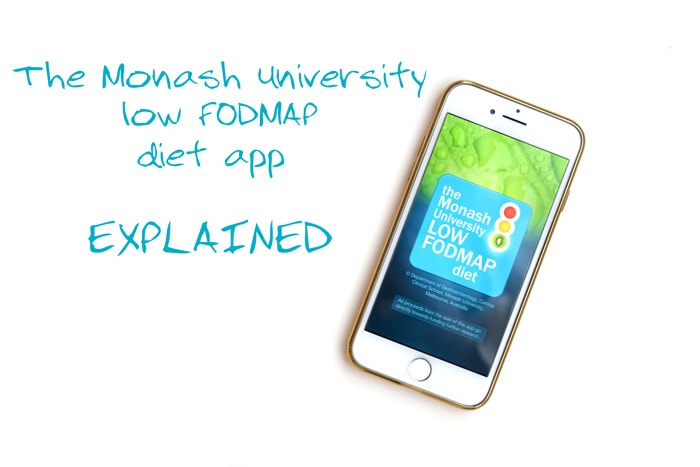
The Monash University low FODMAP diet app explained
I saw quite a lot of questions about the Monash University low FODMAP diet app on Facebook lately. The Monash University low FODMAP diet app is the official app created by the creators of the low FODMAP diet from Monash University in Australia.
I can recommend everybody to buy this app because it gives you information about low FODMAP foods and products and the app is continuously updated when new research has been conducted.
When you are just starting the app might be a bit difficult to understand and therefore I wanted to give some extra information on the app.
The Monash University low FODMAP diet app
The app costs $7,99 in the app store. This might seem quite a high price for an app, but the money that is made with the app is used for research for the low FODMAP diet and the information they find in research is helping us again.
Therefore the costs you make when you buy the app are also in your advantage. Next to that the app is continuously updated. Monash University is always testing new products on their FODMAP content and if they have tested new products, these products are added to the app.
For example, some time ago after retesting the low FODMAP amounts for tomato and bell pepper were changed. And also new products are added to the app continuously.
Information you find on the internet often doesn’t get adapted so quickly and can be outdated. With the app you are sure you have the latest information.
How does the app work
In the app, you can find general information about the low FODMAP diet, some low FODMAP recipes and, most importantly, a list of foods and products.
If you click on dairy on the first page, then on the plus symbol and then on the apple with the arrow, you end up in a place where you can select the different FODMAP groups and look at which foods you can use for each group for reintroducing.
And the suggested amounts. This is very handy for the reintroduction phase.
In the food list, with every product is shown whether it is low FODMAP or not, which FODMAPs are in it and up to what amount the food is low FODMAP.
Because there are many products in the low FODMAP diet that are only low FODMAP up to a limited amount, this app gives a lot of useful information because you can check the amounts you can eat instantly.
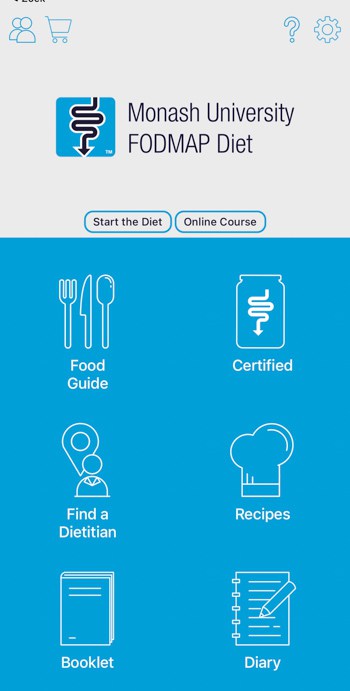
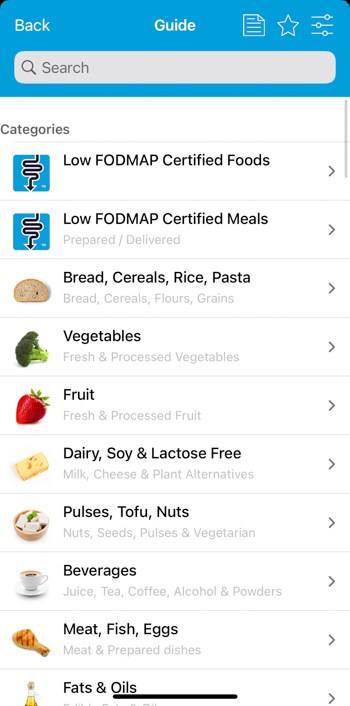
The FODMAP groups
The low FODMAP diet consists of six groups of FODMAPs:
- Fructose (can be found in for example fruit and honey)
- Galactans (GOS)(legumes)
- Fructans (can be found in for example bread, garlic and onion)
- Lactose (can be found in dairy products)
- Sorbitol (can be found in for example avocado and blackberries)
- Mannitols (can be found in for example sweet potato and mushrooms)
Galactans and fructans form the oligosaccharides group together (the “O” in FODMAP) and sorbitol and mannitol form the polyols group (the “P” in FODMAP).
The traffic light system
When you look at a product in the Monash University low FODMAP diet app you see six circles, one for each of the FODMAP groups. The circles are the so-called traffic light system.
A red circle means that a product is high in that specific FODMAP, green means low and orange means moderate.
If a food has one or more red traffic lights, this means it is high in FODMAPs and that you have to avoid that food. It is important to click on the product when you are looking at the app.
If you are scrolling through the list of foods, you might see several traffic lights below the name of a food. This means the food has a red serving, but might also have an orange and/or green serving.
Take for example roma tomatoes. In the list you see a green traffic light, at 75 g. But also a orange and red traffic light at 200 and 300 gram.
This means roma tomatoes are safe to eat in a serving of 75 gram. But become moderately high in the FODMAP group fructans at 200 gram and high at 300 gram.
So the yellow and red servings are something to be careful with and avoid when you are still in the elimination phase.
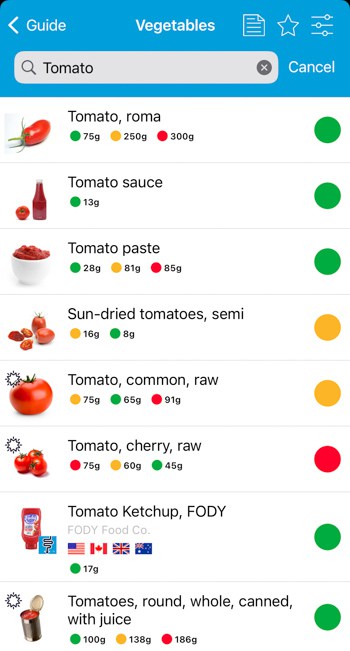
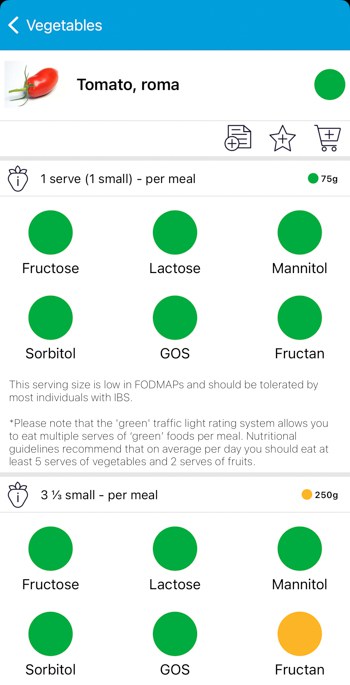
The product page
When you view the page for a specific product in the app, you can see that Monash University uses the traffic light system for two different things.
Firstly the traffic lights for each FODMAP group show in which FODMAP groups the food is low, moderate or high, in different serving sizes.
Next to that, in the upper right corner, Monash University shows the “conclusion” for this specific food.
For roma tomatoes, you see a green traffic light in the upper left corner. This means that a normal serving of this food is low in FODMAP (75 gram in this case).
For spelt pasta, you see a red traffic light in the upper right corner. For this food 148 gram cooked spelt pasta is high in FODMAPs. 74 gram of cooked spelt pasta is low FODMAP.
Because you normally would eat quite a bit more than 74 gram of cooked spelt pasta in one serving, the food spelt pasta is marked as high in FODMAPs.
But you can safely eat 74 gram of cooked spelt pasta if you wish. The serving size is just quite small.
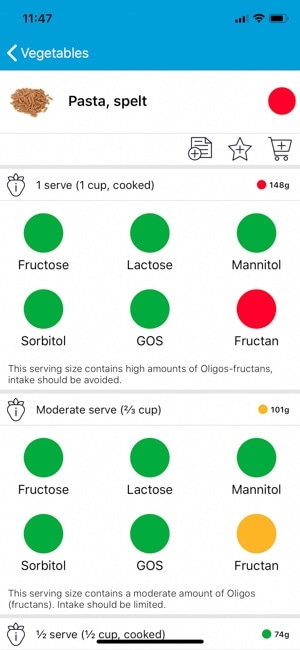
The product overview
On the product overview page, for example in the vegetable categorie, you can quickly scan from a lot of foods in which amounts they contain a high, moderate or low amount of FODMAPs.
In earlier versions of the app, Monash only showed one traffic light for each food and because of that people quickly thought you couldn’t eat a certain food.
Whilst they did have a small low FODMAP serving size. Luckily they have changed this, so you can see the serving sizes for a low, moderate and high FODMAP serving easily.
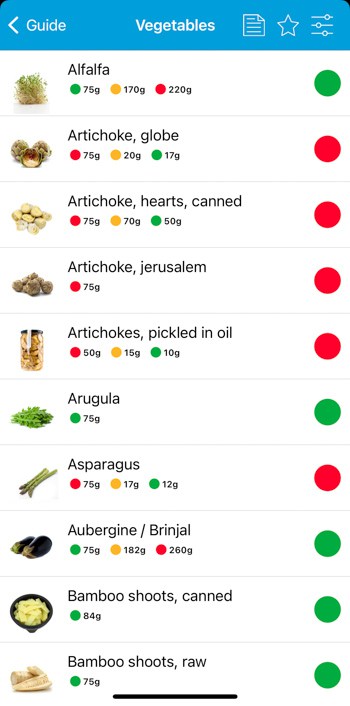
Serving sizes in the app
Foods that can be eaten freely
The Monash University low FODMAP diet app works with serving sizes. Often a serving size is one cup and for some foods, the serving is quite a small amount and this can be a bit confusing. Take spinach for example, one portion of spinach is 2 cups or 75 gram.
But what if you usually like to eat 100 gram of spinach or more? The question that might pop up in your head is, can I only have 75 gram or 2 cups at a time?
Luckily the text below the traffic lights gives some more information and therefore it is important to always read this text.
In the text, Monash University explains whether there is a maximum amount that you can have off a product before it becomes high in FODMAPs and it also tells you when there are no FODMAPs found in a food.
On the spinach page it says: “This serving size is low in FODMAPs and intake should be tolerated by most individuals with IBS. Eet freely and according to appetite.
This means that you can actually eat more than those 2 cups of spinach at a time and you can enjoy it freely and without limitations.
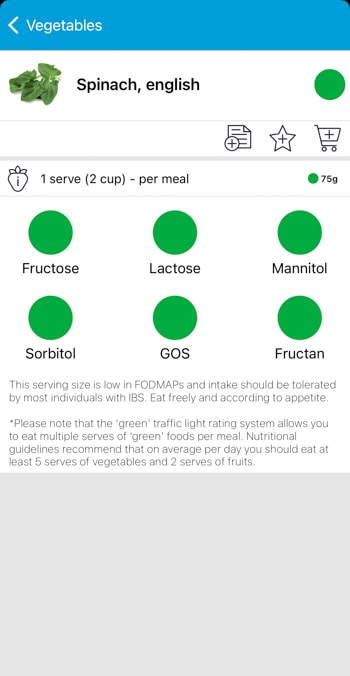
Foods with a limited low FODMAP serving
Another example: tomato. For this food the amounts changed in 2022. It used to be a food that you can eat freely, like spinach. But now it says: 1 serve, 1/2 tomato or 75 gram, is moderately high in fructose.
If you scroll a bit down you see that a low/green serve is 1/2 tomato or 65 gram. This is a bit confusing because it both says 1/2 tomato.
In this case I would advise you to weigh the amounts of tomato you eat in gram, as the difference between 65 and 75 gram is very small.
Apparently, you can still safely eat 65 gram of tomato, but 75 gram is already moderately high in fructose.
If you are still in the elimination phase or know that you react to fructose, it is smart to stay within that safe serving size of 65 gram.
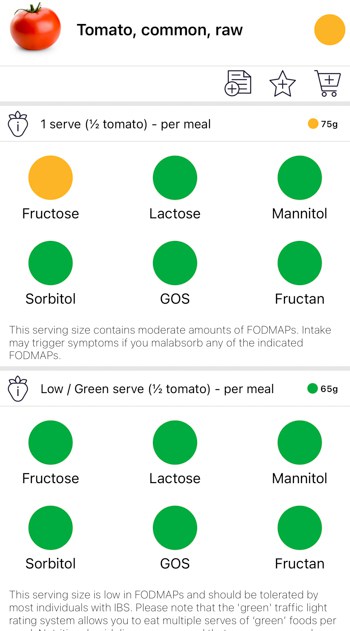
Foods with no clear maximum serving
Finally, at some foods, no extra explanation is given in the text. Take for example sourdough spelt bread (Aus). The serving size is two slices and in the text, it says: this serving size is low in FODMAPs and should be tolerated by most individuals with IBS.
They don’t give a maximum amount, but they also don’t say that this food does not contain FODMAPs. In this case, the advice is to keep to the suggested serving size.
Eat 2 slices of sourdough spelt bread at a time maximum and if you want you can test by yourself (after the elimination phase) whether you tolerate more.
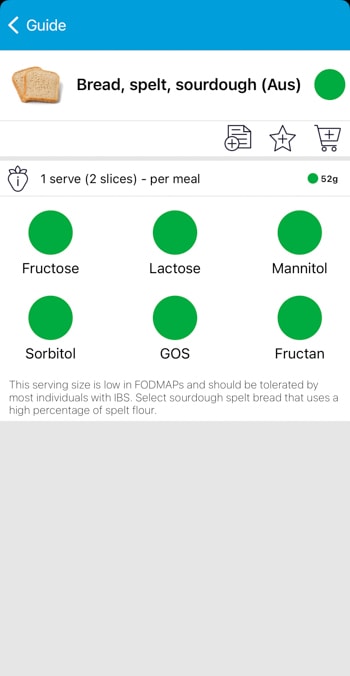
What if the difference between the green and orange serving size is very big?
Sometimes you see that the difference between the green and orange amount in the app is very high. For example for broccoli, as you can see below.
A green serving of broccoli is 75 gram and an orange serving is 270 gram. Because broccoli only contains a moderate amount of FODMAPs at 270 gram, you can probably eat more than 75 gram per serving safely.
I always advice the following:
- In the elimination phase: stick to the green amount if you want to be 100% sure that you are safe.
- Or: take a slightly larger amount than the green serving, but make sure you stay well below the orange serving. Eat for example 150 tot 200 gram of broccoli.
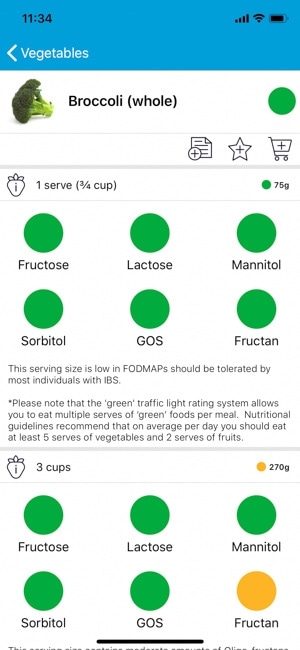
What if a food is not in the app?
Many foods can be found in the app and new foods are being added all the time, but what if you can’t find a food in the app?
In most cases, this means that the food has not been tested yet by Monash University. What you can do best, in this case, is test a small serving of this product yourself, after you have finished the elimination phase.
If you tolerate it you use it and test a bigger amount, if you don’t tolerate it you don’t eat it.
In some cases, it just requires some logical thinking. Some time ago I found spelt noodles and these were not in the app. I knew that spelt pasta was low FODMAP up to 70 gram (cooked) so I expected that spelt noodles would be the same.
I tested how I reacted to 70 gram of spelt noodles and when that went well, I increased the amount and tested that.
Finally, it is always important to check the ingredient list of a product, even if the low FODMAP app says it is low FODMAP.
For example, sourdough spelt bread is low FODMAP up to two slices per serving, but it is possible that a sourdough spelt bread that you find in the shop contains some high FODMAP ingredients. Just make sure to check the ingredient list before you buy something.
Summary
- The green, orange and red traffic lights show which FODMAPs a product contains and whether the food contains a high, moderate or low amount of FODMAPs.
- Don’t just look at the list of foods, but always click on a food to look at the different serving sizes.
- Always read the text below the traffic lights. This tells you exactly how much you can eat off a product and until which amount it is low in FODMAPs.
- Is a food not in the app? Test it yourself, after the elimination phase and start with a small serving.
You can find the page from Monash University about the app here.
Hopefully, this makes the information in the Monash University low FODMAP diet app a bit more clear! If you have any more questions, feel free to ask them in the comments below or send me an e-mail 🙂

13 Comments
This is so helpful and thorough, thank you!
Glad to hear, Lisa!
Thank you Karlijn for taking the time to thoroughly explain about this app. I wanted to buy the app initially and had second thoughts on how useful it would be but your explanation has convinced me to purchase it. ANDDDD! I truly appreciate the sincerity and passion you have put in your website in helping all of us greatly benefit from having a healthy lifestyle! :D!
You’re welcome! I am happy to hear I could help 🙂
I was just wondering if the lowfodmap serving for sweet potato is the raw weight or cooked weight?
I always stick to the raw weight, just to be safe
Thanks Karlijn. I want to buy this app. If I buy it can I use it on my phone and my iPad? Does it only cover one devise? I really enjoy reading your emails and your journey.
I think you can use it on more than one device!
Is it possible to make a selection/list in the Monash App of the food where no Fodmaps were detected?
Thanks for your reply, Karlijn! Your website iis much appreciated, great work!
Marion (2nd week elimination)
Hi Marion, as far as I know that is not possible, unfortunately.
Thank you for the kind words 🙂
That was great I for information.
Are the dietitians free when buying the app? Is the $7.99 for the app a one time cost?
I am not sure what you mean about the dietitians. But the app is a one time cost indeed.